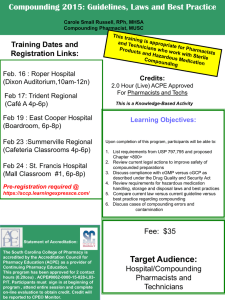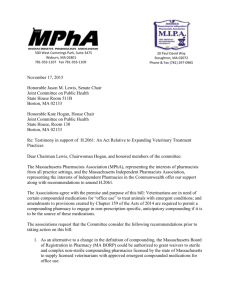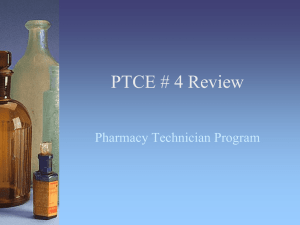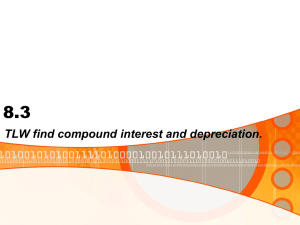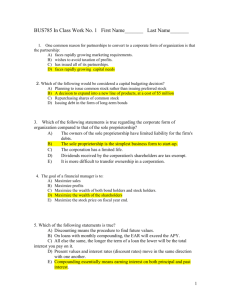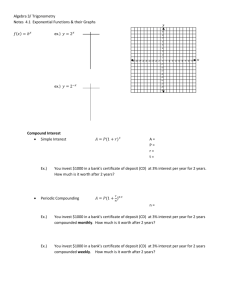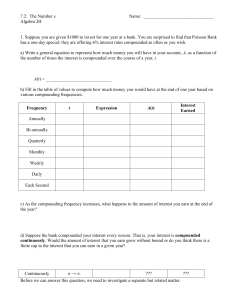Radiopharmaceutical Compounding Practices
advertisement
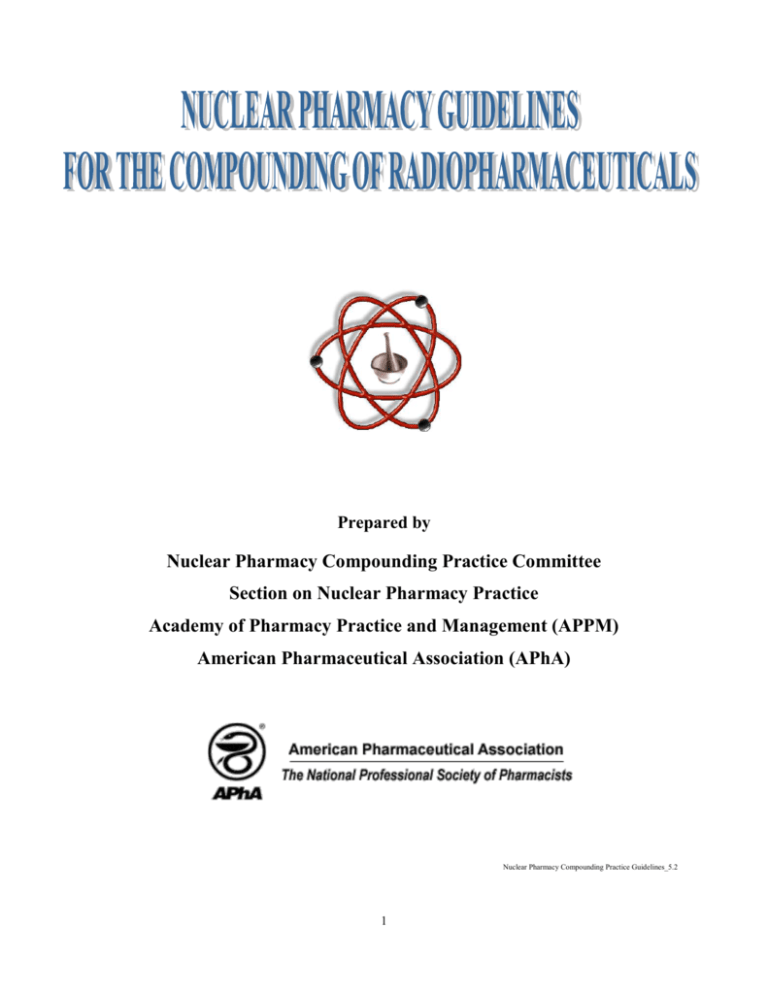
Prepared by Nuclear Pharmacy Compounding Practice Committee Section on Nuclear Pharmacy Practice Academy of Pharmacy Practice and Management (APPM) American Pharmaceutical Association (APhA) Nuclear Pharmacy Compounding Practice Guidelines_5.2 1 TABLE OF CONTENTS COMMITTEE MEMBERS ...........................................................................................................................................4 ABBREVIATION LIST ................................................................................................................................................7 DEFINITIONS ..............................................................................................................................................................8 INTRODUCTION ....................................................................................................................................................... 10 GENERAL PROVISIONS .......................................................................................................................................... 11 ORGANIZATION AND PERSONNEL ..................................................................................................................... 14 COMPOUNDING ENVIRONMENT ......................................................................................................................... 16 Facilities .................................................................................................................................................................. 16 Equipment ............................................................................................................................................................... 18 SOURCES OF COMPOUNDING DRUG COMPONENTS ...................................................................................... 19 Bulk Drug Substance .............................................................................................................................................. 19 Non-Bulk Drug Substance ...................................................................................................................................... 19 QUALITY CONTROL................................................................................................................................................ 21 Compounded Reagent Kits ..................................................................................................................................... 21 Compounded Radiopharmaceuticals....................................................................................................................... 21 Quality Control of 99mTc Eluate ......................................................................................................................... 21 Visual Inspection of Product .............................................................................................................................. 21 Assessment of Radioactivity and Quality Control of Radionuclide (Dose) Calibrators .................................... 21 Radionuclidic Purity .......................................................................................................................................... 21 Radiochemical Purity ......................................................................................................................................... 22 pH....................................................................................................................................................................... 22 Verification of Macroaggregate Particle Size .................................................................................................... 22 Imprinted Labeling ............................................................................................................................................. 22 Microbiological Controls and Bacterial Endotoxin Testing ............................................................................... 22 Compounded PET Drugs ................................................................................................................................... 23 STABILITY OF COMPOUNDED PREPARATIONS ............................................................................................... 24 PRIMARY PACKAGING OF COMPOUNDED PREPARATIONS ......................................................................... 25 2 IMPRINTED LABELING FOR COMPOUNDED PREPARATIONS ...................................................................... 26 COMPOUNDING RECORDS AND DOCUMENTS................................................................................................. 27 STORAGE ................................................................................................................................................................... 28 REFERENCES ............................................................................................................................................................ 29 3 COMMITTEE MEMBERS Joseph C. Hung, Ph.D., BCNP (Chair) Consultant and Associate Professor of Radiology Director of Nuclear Pharmacy and PET Laboratory Nuclear Medicine Department of Diagnostic Radiology Mayo Clinic 200 First Street SW Rochester, MN 55905 Phone; (507) 284-4399 Fax: (507) 266-4461 E-mail: jhung@mayo.edu Samuel C. Augustine, Pharm.D., BCNP Associate Professor College of Pharmacy, Department of Pharmacy Practice College of Medicine, Department of Pathology and Microbiology Director of the Antibody Labeling Coordinator of Experiential Training 986045 Nebraska Medical Center Omaha, NE 68198-6045 Phone: (402) 559-5774 Fax: (402) 559-5673 E-mail: saugusti@unmc.edu Kenneth T. Cheng, Ph.D., BCNP, FAPhA Associate Professor and Director of Nuclear Pharmacy Program Department of Pharmaceutical Sciences College of Pharmacy Medical University of South Carolina 171 Ashley Avenue Charleston, SC 29425 Phone: (843) 792-7458 Fax: (843) 792-0759 E-mail: chengk@musc.edu Richard L. Green, R.Ph., BCNP Adjunct Associate Professor of Bionucleonics Butler University College of Pharmacy and Health Sciences Program Manager – Pharmacy Practice Quality & Regulatory Department Syncor International Corporation 6464 Canoga Avenue Woodland Hills, CA 91367 Phone: (818) 737-4537 Fax: (818) 737-4848 E-mail: greenr@syncor.com 4 Wade M. Hopkins, BCNP Pharmacy Manager Syncor International Corporation 8389 Almeda, Suite G Houston, TX 77054 Phone: (713) 748-3303 Fax: (713) 748-0029 E-mail: hopkinsw@syncor.com David L. Laven, NPh, CRPh, FASHP, FAPhA Cyclotron Manager – Nuclear Pharmacist and Poison Control Specialist Departments of Pharmacy and Radiology 400B – KUH University of Kansas Medical Center 3901 Rainbow Boulevard Kansas City, KS 66160-7231 Phone: (913) 588-6633 Fax: (913) 588-2350 E-mail: dlaven@kumc.edu Brigette R. McGhee, M.S., Pharm.D., R.Ph., BCNP Jacksonville Central Pharmacy 6950 Phillips Highway, Suite 26 Jacksonville, FL 32216 Phone: (904) 332-0888 Fax: (904) 332-0880 E-mail: mcgheeb@bellsouth.net Neil A. Petry, R.Ph., M.S., BCNP, FAPhA Assistant Professor of Radiology Director, Radiopharmacy and Nuclear Medicine Laboratory Duke University Medical Center 133 Bell Building, Box 3304 Durham, NC 27710 Phone: (919) 684-3773 Fax: (919) 660-9743 E-mail: petry005@mc.duke.edu James A. Ponto, M.S., BCNP Chief Nuclear Pharmacist and Professor (Clinical) Division of Nuclear Medicine Department of Radiology The University of Iowa Hospitals and Clinics 200 Hawkins Drive 3832 JPP Iowa City, IA 52242-1058 Phone: (319) 356-2741 Fax: (319) 356-2220 E-mail: james-ponto@uiowa.edu 5 Timothy M. Quinton, Pharm.D., M.S., BCNP President Radiopharmacy, Inc. 1409 E. Virginia Street Evansville, IN 47711 Phone: (812) 421-1002 Fax: (812) 421-1004 E-mail: quniton@evansville.net Dennis P. Swanson, M.S., BCNP School of Pharmacy University of Pittsburgh 1103 Salk Hall Pittsburgh, PA 15261 Phone: (412) 648-8584 or 8579 Fax: (412) 648-1086 E-mail: swansondp@msx.upmc.edu 6 ABBREVIATION LIST ACARA: As clean as reasonably achievable ACS: American Chemical Society APhA: American Pharmaceutical Association APPM: Academy of Pharmacy Practice and Management AR: Analytical reagent ASHP-TAB: American Society of Health-System Pharmacy Technical Assistance Bulletin on Quality Assurance for Pharmacy – Prepared Sterile Products BET: Bacterial endotoxin testing CFR: Code of Federal Regulations CGMP: Current good manufacturing practices FDAMA: Food and Drug Administration Modernization and Accountability Act FCC: Food Chemicals Codes FDA: Food and Drug Administration MOU: Memorandum of understanding NF: National Formulary PET: Positron Emission Tomography RCP: Radiochemical purity USP: United States Pharmacopeia 7 DEFINITIONS The following selective definitions apply to the Nuclear Pharmacy Guidelines for the Compounding of Radiopharmaceuticals: ACARA (as clean as reasonably achievable) means making every reasonable effort to maintain clean conditions, as much as one can possibly achieve without significantly compromising radiation protection. Bulk Drug Substance means any substance that is represented for use in a drug and that, when used in the manufacturing, processing, or packaging of a drug, becomes an active ingredient of a finished dosage form of the drug, but the term does not include intermediates used in the synthesis of such substances. Component means any ingredient (active or non-active) intended for use in the compounding of a drug product, including those that may not appear in such product (i.e., intermediate). Compounding means the preparation, mixing, assembling, packaging, or labeling of a drug (including a reagent kit or a radiopharmaceutical) (1) as the result of a practitioner’s prescription order or initiative based on the practitioner/patient/pharmacist relationship in the course of professional practice, or (2) for the purpose of, or as an incident to, research, teaching, or chemical analysis and not for sale or dispensing. Compounding also includes the preparation of drugs (including reagent kits and radiopharmaceuticals) in anticipation of prescription orders based on routine, regularly observed prescribing patterns. Please also refer to the General Provisions section for further description regarding nuclear pharmacy compounding practices. Compounding area means the physical space used for the compounding activity, such as the surface of a countertop, the interior of a laminar flow hood, or the interior of an enclosed glove box, etc. Intermediate means an ingredient (other than a bulk drug substance) intended for use in the compounding of a drug product which does not appear in the final drug product. Non-bulk Drug Substance means any non-active ingredient or intermediate of a drug product. Nuclear Pharmacist means one that has state licensure as a pharmacist or nuclear pharmacist (as applicable), and meets the training requirements for an authorized or experienced nuclear pharmacist as stated in Title 10, Code of Federal Regulations (10 CFR), Part 35.980 Training for an authorized nuclear pharmacist13 and 35.981 Training for experienced nuclear pharmacist114. Practitioner or Prescribing Practitioner means an individual licensed or otherwise authorized to prescribe and use radiopharmaceuticals. In the case where the practitioner is a veterinarian, “patient” means an animal under his/her care. Prescription Order means an order for medication issued by a practitioner (prescribing practitioner) to be filled by a nuclear pharmacist for use in a specific patient of the prescriber. Medication Order or Notation is similar to prescription order, but is intended for a patient in an institutional setting. Radiopharmaceutical or Radioactive Drug means a drug that exhibits spontaneous disintegration of unstable nuclei with the emission of nuclear particles or photons, including any 8 nonradioactive reagent kit or radionuclide generator that is intended to be used in the preparation of any such substance. Radiopharmaceuticals or radioactive drugs include, but are not limited to, positron emission tomography (PET) agents, radiolabeled antibodies and peptides, radiolabeled blood-formed elements, and any substance as defined by Section 201 (g)(1) of the Federal Food Drug and Cosmetic Act6, and shall include nonradioactive diagnostic kits and other drugs or components incident to the preparation and use of such radiopharmaceuticals or radioactive drugs. This definition does not include drugs such as carbon-containing compounds or potassium-containing salts, which contain trace quantities of naturally occurring radionuclides. Radiopharmaceuticals or radioactive drugs are to be dispensed only upon receipt of a prescription or medical order/notation from an authorized licensed practitioner or through his/her agent or researcher. Reagent Kit means a sterile and pyrogen-free reaction vial containing the nonradioactive chemicals [e.g., complexing agent (ligand), reducing agent, stabilizer, or dispersing agent] that are required to produce a specific radiopharmaceutical after reaction with a radioactive component. Stability means that extent to which a drug preparation maintains within specified limits, and throughout its period of storage and use, the same properties and characteristics that it possessed at the time of compounding. As used here, the term “stability” does not apply to radioactive decay. 9 INTRODUCTION Nuclear pharmacy compounding, like traditional pharmacy compounding, is an integral part of pharmacy practice and is essential to the provision of health care and delivery of a cost-effective radiopharmaceutical service. Both nuclear pharmacy and traditional pharmacy compounding practices are regulated by the individual state boards of pharmacy and other regulatory agencies. Nuclear pharmacists must be familiar with statutes and regulations that govern compounding because these requirements vary from state to state. Nuclear pharmacy compounding can be as simple as adding a radioactive liquid to a commercially available reagent kit, or as complex as the creation of a multi-component reagent kit or the synthesis of a radiolabeled compound via a multi-step preparation process. Compounding is different from manufacturing, which is guided by current good manufacturing practices (CGMP’s) [see United States Pharmacopeia (USP) <1078> Good Manufacturing Practices for Bulk Pharmaceutical Excipients24]. Some of the characteristics or criteria that differentiate compounding from manufacturing include the existence of specific practitioner-patient-pharmacist relationships; the quantity of medication prepared in anticipation of receiving a prescription or a prescription order; and the conditions of sale, which are limited to specific prescription orders. The recommendations contained herein are considered to be the minimum current good compounding practices for the compounding of reagent kits and radiopharmaceuticals by a licensed pharmacist for dispensing and/or administration to humans or animals in a state licensed pharmacy or a federal facility. The Nuclear Pharmacy Guidelines for the Compounding of Radiopharmaceuticals are in addition to the Nuclear Pharmacy Practice Guidelines3 established by the Section on Nuclear Pharmacy Practice, APhA-APPM, USP <823> Radiopharmaceuticals for positron emission tomography – compounding23, and FDA’s final regulations on Current Good Manufacturing Practices for Positron Emission Tomography Drug Products. 10 GENERAL PROVISIONS 1. The compounding of reagent kits or radiopharmaceuticals and the dispensing of compounded preparations shall be in compliance with the requirements established by the individual state boards of pharmacy and other regulatory agencies. 2. Based on the existence of a practitioner-patient-pharmacist relationship and the presentation of an unsolicited and valid prescription order or a notation, approved by the prescribing practitioner, which states that a compounded product is necessary for an identified individual patient, a nuclear pharmacist may compound reagent kits and radiopharmaceuticals in a nuclear pharmacy, a nuclear medicine laboratory, or a federal facility. 3. Nuclear pharmacy compounding does not include mixing, reconstituting, or other such acts that are performed in accordance or consistent with the directions contained in approved labeling or other manufacturer directions consistent with that labeling. Nuclear pharmacy compounding also does not include any deviation(s) from the directions contained in the approved product labeling or other manufacturer directions consistent with that labeling which result in a final radioactive drug product that is of the same quality and purity as that produced with adherence to the product labeling. The nuclear pharmacist should use his/her professional judgement, scientific knowledge, literature evidence, etc., as the basis to perform any deviation(s) from the manufacturer’s recommended preparation process, and the final product should be checked by the appropriate quality control process as described in the Quality Control section or other reliable source(s). 4. Reagent kits and/or radiopharmaceuticals may also be compounded for the purpose of, or incidental to, research, teaching, or chemical analysis. However, these types of compounded preparations are not for sale or dispensing for patient use. 5. The compounding of non-radioactive drugs, except reagent kits, shall be subject to the provisions of the Food and Drug Administration Modernization and Accountability Act (FDAMA)15 and the guidelines of the USP. 6. The finished compounded drug products are exempted from the requirements of the Federal Food, Drug, and Cosmetic Act for CGMP’s7, “adequate directions for use” on the drug label8, and new drug applications9. 7. The nuclear pharmacist is responsible for compounding preparations of acceptable strength, quality, and purity, utilizing appropriate packaging and labeling in accordance with good compounding practice, official standards, and relevant scientific data and information. 8. The nuclear pharmacist may compound reagent kits and radiopharmaceuticals in limited quantities in anticipation of the receipt of a valid prescription order or a notation, approved by the prescribing practitioner. The quantity of compounded reagent kits and radiopharmaceuticals is based on the past history of the nuclear pharmacist receiving valid prescription orders or notations, approved by the prescribing practitioner, for the compounding of the drug products. 9. The nuclear pharmacist does not compound a reagent kit or radiopharmaceutical that appears on a list, published by the FDA in the Federal Register, of drug products that have been withdrawn or removed from the market because such drug products or components of such drug products have been found to be unsafe or not effective; nor does a nuclear pharmacist compound a reagent kit or 11 radiopharmaceutical using bulk drug substances or non-bulk drug substances that could result in a final radioactive drug product that is potentially unsafe or not effective. 10. The nuclear pharmacist may compound a reagent kit or radiopharmaceutical that has been previously approved by the Food and Drug Administration (FDA), but is no longer commercially available [does not include a reagent kit or radiopharmaceutical that has been withdrawn or removed from the market because such drug product or component(s) of such drug product has been found to be unsafe or not effective]. 11. The nuclear pharmacist does not compound regularly or in inordinate amounts (as defined by the FDA and/or state board of pharmacy) any reagent kits or radiopharmaceuticals that are essentially copies of a commercially available drug product. However, the term “essentially a copy of a commercially available drug product” does not apply to a drug product in which there is a change made for an identified individual patient which produces for that patient a significant difference, as determined by the prescribing practitioner, between the compounded drug and the comparable commercially available drug product. The term “essentially a copy of a commercially available drug product” also does not apply to PET radiopharmaceuticals. 12. The nuclear pharmacist should not compound any patented reagent kit or radiopharmaceutical unless it is not reasonably available to meet the urgent medical need(s) of an identified individual patient. This is allowed only when the patented reagent kit or radiopharmaceutical cannot be readily obtained from a commercial source, and the prescriber shall be informed that a reagent kit or a radiopharmaceutical will be compounded to replace the commercial product. 13. A reagent kit or radiopharmaceutical may be compounded only if such drug product has not been identified by FDA regulation as a drug product that presents demonstrable difficulties for compounding that reasonably demonstrates an adverse effect on the safety or effectiveness of that drug product. 14. A reagent kit or radiopharmaceutical may be compounded only if such drug product is compounded in a state – (1) that has entered into a memorandum of understanding (MOU) with the FDA which addresses the interstate distribution of inordinate amounts of compounded drug products and provides for appropriate investigation, by a state agency, of complaints relating to compounded drug products distributed outside such state; or (2) that has not entered into the MOU described in the previous clause and the nuclear pharmacist or nuclear pharmacy distributes (or causes to be distributed) compounded drug products out of the state in which they are compounded, in quantities that do not exceed 5 percent of the total prescription orders dispensed or distributed by such nuclear pharmacy. 15. The nuclear pharmacy and nuclear pharmacist shall not advertise or promote the compounding of any particular drug, class of drug, or type of drug. The nuclear pharmacy and nuclear pharmacist may advertise or otherwise promote the fact that they provide prescription compounding services; however, the advertising and promoting of compounding services shall be in compliance with applicable laws and regulations. 16. Nuclear pharmacists engaging in compounding should continually expand their compounding knowledge and enhance their compounding skills by participating in seminars and workshops, studying appropriate literature, and consulting with colleagues. 12 17. A practitioner may obtain compounded drug products from a nuclear pharmacy to administer to an identified individual patient under his/her care in the course of his/her professional practice. In addition to the labeling requirements of the state and federal regulations, the compounded drug products requested by the practitioner should also be labeled “For Office Use Only.” 18. Compounded reagent kits and radiopharmaceuticals are not for resale outside the prescriber and patient relationship involved with the prescription order or notation approved by the prescribing practitioner. 19. These provisions apply to the operation of an accelerator or nuclear reactor to produce radionuclides and radiochemicals for the compounding of radioactive drugs, including PET radiopharmaceuticals. For the compounding of PET radiopharmaceuticals, please refer to USP <823> Radiopharmaceuticals for Positron Emission Tomography – Compounding23 and FDA’s final regulations on Current Good Manufacturing Practices for Positron Emission Tomography Drug Products. 13 ORGANIZATION AND PERSONNEL 1. The nuclear pharmacist has the responsibility and authority to inspect and approve or reject all components, drug product containers, closures, in-process materials, labeling, as well as the authority to prepare and review all compounding records to assure that no errors have occurred in the compounding process. The nuclear pharmacist is also responsible for the proper maintenance, cleanliness, and use of all equipment used in prescription compounding practice. 2. All nuclear pharmacists who engage in compounding of drugs shall be proficient in the art of compounding and shall maintain proficiency through current awareness and training. Also, every nuclear pharmacist who engages in drug compounding must be aware of, and familiar with, all details of good compounding practices. 3. The practice of nuclear pharmacy compounding may also be performed by a nuclear pharmacist intern, who must be under the immediate and personal supervision of a nuclear pharmacist. 4. Nuclear pharmacy technicians may assist the nuclear pharmacist in compounding. It is the responsibility of the nuclear pharmacist to train and monitor the nuclear pharmacy technician. For the training program specific to nuclear pharmacy technicians, it is recommended to refer to the Proposed Guidelines for Nuclear Pharmacy Technician Training Programs5 prepared by the Ad Hoc Committee on Nuclear Pharmacy Technicians, Section on Nuclear Pharmacy Practice, APhA-APPM. The duties of nuclear pharmacy technicians shall be consistent with the training received. 5. Nuclear pharmacists as well as all personnel involved with compounding should participate in programs designed to enhance and maintain competence in compounding. Procedures should be established to verify the ability of staff to meet established competencies. These procedures may include observation, written tests, or quality control testing of finished products. 6. To protect drug products from contamination, personnel engaged in nuclear pharmacy compounding practice should wear clean clothing appropriate to the operation being performed. To protect personnel from chemical exposure and medication or chemical contamination, personnel shall wear protective apparel, such as coats/jackets, aprons, gowns, as well as head, face, hand, and arm coverings, safety goggles, and a mask or respirator, etc. 7. Only personnel authorized by the responsible nuclear pharmacist shall be in the immediate vicinity of the drug compounding operation. Any person shown at any time (either by medical examination or nuclear pharmacist determination) to have an apparent illness or open lesion(s) that may adversely affect the safety or quality of a drug product being compounded shall be excluded from direct contact with components, drug product containers, closures, in-process materials, and drug products until the condition is corrected, or determined by competent medical personnel not to jeopardize the safety or quality of the product(s) being compounded. All personnel who assist the nuclear pharmacist in compounding procedures shall be instructed to report to the nuclear pharmacist any health conditions that may have adverse effects on drug products. 8. For the compounding of reagent kits and radiopharmaceuticals that belong to the high-risk category II [as defined in the United States Pharmacopeia (USP) <1206> Sterile Drug Products for Home Use27) and/or risk level 3 [as defined in the American Society of Health-System Pharmacy Technical Assistance Bulletin on Quality Assurance for Pharmacy-Prepared Sterile Products (ASHP-TAB)1], it is recommended to refer to USP <1206> monograph27 and ASHP-TAB1 for further guidance regarding organization and personnel for these types of radiopharmaceuticals. 14 9. For compounded PET drugs, please refer to the FDA’s final regulations on Current Good Manufacturing Practices for Positron Emission Tomography Drug Products for further requirements with regard to organization and personnel. 15 COMPOUNDING ENVIRONMENT Facilities 1. Nuclear pharmacies engaging in compounding should have a specifically designated and adequate area with limited access for the orderly placement of equipment and materials to prevent mix-ups between ingredients, containers, labels, in-process materials, and finished preparations. The compounding area should also be designed, arranged, used, and maintained to prevent crosscontamination. 2. Adequate lighting, heating, ventilation, and air-conditioning systems should be provided in all drugcompounding areas. The compounding area should not contain dust-collecting overhangs (e.g., ceiling, utility pipes, hanging light fixtures) and ledges (e.g., windowsills). The area(s) used for the compounding of drugs shall be maintained in a good state of repair. 3. The area(s) used for the compounding of drugs should be maintained in a clean and sanitary condition. Adequate washing facilities, easily accessible to the compounding area(s) of the nuclear pharmacy, should be provided. These facilities should include, but not be limited to, hot and cold water, soap or detergent, and air-dryers or single-service towels. Compounding areas should be free of infestation by insects, rodents, and other vermin. Sewage, trash, and other refuse in the compounding area should be disposed of in a safe, sanitary, and timely manner. 4. Potable water should be supplied for hand and equipment washing. Potable water should be supplied under continuous positive pressure in a plumbing system free of defects that could contribute contamination to any compounded drug product. Purified water must be used for compounding nonsterile drug preparations and must also be used for rinsing equipment and utensils. When water is used to prepare a sterile preparation, Water for Injection, Sterile Water for Injection, or Bacteriostatic Water for Injection must be used. 5. Areas in the nuclear pharmacy used for the compounding of sterile products should be separate and distinct from the compounding or dispensing of non-sterile drug products. The compounding of sterile products in a nuclear pharmacy should be performed using an aseptic technique. However, the concept of “as clean as reasonably achievable” (ACARA) should be applied to the compounding of sterile products in a nuclear pharmacy whenever both sterility and radiation safety issues are considerations. 6. To minimize dust and particulate matter, cartons and boxes should not be stored or opened in the compounding area. Computer entry, order processing, label generation, and record keeping should be performed outside the compounding area. 7. Storage areas should provide an environment suitably controlled to ensure quality and stability of bulk and/or non-bulk drug substances and finished preparations. Bulk drug substances and nonbulk drug substances used in the compounding of drugs must be stored in adequately labeled containers in a clean, dry, and temperature-controlled area or, if required, in proper refrigeration. 8. For the compounding of reagent kits and radiopharmaceuticals that belong to the high-risk category II [as defined in the United States Pharmacopeia (USP) <1206> Sterile Drug Products for Home Use27) and/or risk level 3 [as defined in the American Society of Health-System Pharmacy Technical Assistance Bulletin on Quality Assurance for Pharmacy-Prepared Sterile Products (ASHP-TAB)1], it is recommended to refer to USP <1206> monograph27 and ASHP-TAB1 for 16 further guidance regarding facilities. However, the ACARA principle should be considered whenever radiation safety becomes an issue of concern for the compounding of these types of radiopharmaceuticals. 9. For compounded PET drugs, please refer to the FDA’s final regulations on Current Good Manufacturing Practices for Positron Emission Tomography Drug Products for further requirements with regard to facilities for compounding PET drugs. 17 Equipment 1. It shall be the responsibility of the nuclear pharmacist to inspect the equipment and utensils for compounding immediately prior to use to determine if these items are suitable for usage. 2. Equipment used in the compounding of drug products shall be of appropriate design, adequate size, and suitably located to facilitate operations for its intended use, as well as its cleaning and maintenance. The types and sizes of equipment will depend on the dosage forms and the quantities compounded. For further information, please refer to USP <41> Weights and Balances17, <1176> Prescription Balances and Volumetric Apparatus26, and equipment manufacturers’ instruction manuals. 3. Equipment used in the compounding of drug products shall be of suitable composition so that surfaces which contact components, in-process materials, or drug products shall not be reactive, additive, or absorptive so as to alter the safety, identity, strength, quality, or purity of the drug product beyond that desired. 4. Equipment and utensils used for compounding shall be cleaned and sanitized to prevent contamination that would alter the safety, identity, strength, quality, or purity of the drug product beyond that desired. Previously cleaned equipment and utensils used for compounding drugs must be protected from contamination prior to use. 5. With regard to equipment, utensils, and containers/closures used in the compounding of sterile drug products, one can refer to the Model Rules for Sterile Pharmaceuticals2 published by the National Association of Boards of Pharmacy for the cleaning, sterilization, and maintenance procedures. 6. Automatic, mechanical, or electronic equipment, or other types of equipment or related systems that will perform a function satisfactorily may be used in the compounding of drug products. If such equipment is used, it shall be cleaned and sanitized prior to use, routinely inspected, calibrated (if necessary) or checked to assure proper performance. 7. The equipment used to perform quality control of the compounded drug preparations shall be routinely inspected, calibrated (if necessary) or checked to assure proper performance. 8. For the compounding of reagent kits and radiopharmaceuticals that belong to the high-risk category II [as defined in the United States Pharmacopeia (USP) <1206> Sterile Drug Products for Home Use27) and/or risk level 3 [as defined in the American Society of Health-System Pharmacy Technical Assistance Bulletin on Quality Assurance for Pharmacy-Prepared Sterile Products (ASHP-TAB)1], it is recommended to refer to USP <1206> monograph27 and ASHP-TAB1 for further guidance regarding equipment. However, the ACARA principle should be considered whenever radiation safety becomes an issue of concern for the compounding of these types of radiopharmaceuticals. 9. Please refer to the FDA’s final regulations on Current Good Manufacturing Practices for Positron Emission Tomography Drug Products for further requirements with regard to equipment for compounding PET drugs. 18 SOURCES OF COMPOUNDING DRUG COMPONENTS Bulk Drug Substance Any bulk drug substance used in the compounding of a reagent kit or radiopharmaceutical is preferred to be one of the following (in descending order of preference): (1) a USP or National Formulary (NF) grade substance (2) an active ingredient of an approved drug product (3) a drug substance that appears on a list developed by the FDA and the United States Pharmacopeia Convention, Incorporated (4) a high quality source of chemical substance, such as a substance which is an analytical reagent (AR), a substance which has been certified by the American Chemical Society (ACS), or a substance which is listed as Food Chemicals Codes (FCC) grade Any bulk drug substance used in the compounding of reagent kits or radiopharmaceuticals should preferably be manufactured by an establishment that meets section 510 of the Federal Food, Drug, and Cosmetic Act10, and each bulk drug substance should be accompanied by a valid certificate of analysis if available. Only manufactured substances from containers labeled with a batch control number and a future expiration date are acceptable as a potential source of bulk drug substances. When compounding with manufactured drug products, the nuclear pharmacist must consider all ingredients present in the substance relative to the intended use of the compounded preparation. For a bulk drug substance used in compounding that is not purchased from a registered drug manufacturer, the nuclear pharmacist should establish identity and purity by reasonable means, which may include, but are not limited to, lot analysis, manufacturer reputation, or reliability of source. Please refer to the FDA’s final regulations on Current Good Manufacturing Practices for Positron Emission Tomography Drug Products for further requirements with regard to sources for bulk drug substances to be used for compounding a PET drug. Non-Bulk Drug Substance Any non-bulk drug substance used in the compounding of a reagent kit or radiopharmaceutical is preferred to be one of the following (in descending order of preference): (1) a USP or NF grade substance (2) a non-active ingredient or an intermediate of an approved drug product 19 (3) a high quality source of chemical substance, such as a substance which is an analytical reagent (AR), a substance which has been certified by the American Chemical Society (ACS), or a substance which is listed as Food Chemicals Codes (FCC) grade Any non-bulk drug substance used in the compounding of reagent kits or radiopharmaceuticals should preferably be manufactured by an establishment that meets section 510 of the Federal Food, Drug, and Cosmetic Act10, and each non-bulk drug substance should be accompanied by a valid certificate of analysis if available. Only manufactured substances from containers labeled with a batch control number and a future expiration date are acceptable as a potential source of non-bulk drug substances. When compounding with manufactured drug products, the nuclear pharmacist must consider all ingredients present in the substance relative to the intended use of the compounded preparation. For a non-bulk drug substance used in compounding that is not purchased from a registered drug manufacturer, the nuclear pharmacist should establish identity and purity by reasonable means, which may include, but are not limited to, lot analysis, manufacturer reputation, or reliability of source. Please refer to the FDA’s final regulations on Current Good Manufacturing Practices for Positron Emission Tomography Drug Products for further requirements with regard to the sources for non-bulk drug substances to be used for compounding a PET drug. 20 QUALITY CONTROL Compounded Reagent Kits 1. If the radiolabeled product from the reconstituted compounded reagent kit is listed in the USP, the quality control of the compounded reagent kit can be conducted by testing the radiolabeled product to determine whether it meets all applicable USP standards as described in its monograph. If not, the radiolabeled product should meet professional standards of a similar nature appropriate for its safety and intended use. 2. If necessary, it is also recommended to follow the stipulations as stated in the Quality Control section of USP <1161> Pharmacy Compounding Practices25 for the quality control of compounded reagent kits. 3. It is recommended that reagent kits compounded under high-risk category II (as defined in USP <1206> Sterile Drug Products for Home Use27) and/or risk level 3 (as defined in the ASHP-TAB1) conditions shall be subject to quality control checks or tests as described in the Finished Product Release Checks and Tests under USP <1206> Sterile Drug Products for Home Use27. 4. For compounded reagent kits used in the compounding of PET drugs, please refer to the FDA’s final regulations on Current Good Manufacturing Practices for Positron Emission Tomography Drug Products for further requirements for further quality control requirements. Compounded Radiopharmaceuticals Quality Control of 99mTc Eluate For the quality control of 99mTc eluate, please refer to USP Sodium Pertechnetate Tc 99m Injection16. Visual Inspection of Product Visual inspection of the compounded radiopharmaceutical shall be conducted to ensure the absence of foreign matter and also to help to establish product identity by confirming whether the product is a solution, a colloid, or a macroaggregated suspension. Assessment of Radioactivity and Quality Control of Radionuclide (Dose) Calibrators For the quality control of the radionuclide (dose) calibrator, please refer to 10 CFR Part 35.50 Possession, use, calibration, and check of dose calibrators11 and Part 35.52 Possession, use, calibration, and check of instruments to measure dosages of alpha- or beta-emitting radionuclides12. Radionuclidic Purity For non-technetium products, radionuclidic purity can be determined with the use of a suitable counting assembly (see Selection of a Counting Assembly under USP <821> Radioactivity22). In the 21 absence of USP or equivalent standards, radionuclidic purity specifications should be established based on scientific data and sound rationale. Radiochemical Purity The radiochemical purity (RCP) of compounded radiopharmaceuticals should be monitored before administration to patients. The nuclear pharmacist must select an appropriate RCP testing method based on literature evidence, scientific data, and his/her professional judgement, etc. In the absence of USP or equivalent standards, radiochemical purity specifications should be established a priori based on scientific data and sound rationale. Appropriate and acceptable RCP value of the final compounded radiopharmaceutical should be confirmed using an established and/or validated procedure. In any event, clear, easy-to-follow descriptions of test methods should be readily available to all nuclear pharmacy staff. While both the USP radiopharmaceutical monographs and manufacturer’s package inserts provide standard methods for testing RCP, RCP testing procedures that may be more adaptable to a nuclear pharmacy setting are found in the package insert. Alternative RCP testing methods can be found in the Alternative Radiochemical Purity Testing Procedures for the Compounded Radiopharmaceuticals Approved from 1988-19974 (published by the American Pharmaceutical Association) or in the appropriate literature. pH The pH of the final compounded radiopharmaceutical preparation should be checked to ensure that its value is within the acceptable range as defined by the USP, package insert, or appropriate literature. In the absence of USP or equivalent standards, pH specifications should be established a priori based on scientific data and sound rationale. Verification of Macroaggregate Particle Size The particle size of radiolabeled macroaggregates should be verified to be within the acceptable range, as defined by the USP, package insert, or appropriate literature, prior to use. Imprinted Labeling At the completion of the compounding drug operation, the nuclear pharmacist shall examine the compounded drug product for correct labeling as required by the appropriate Nuclear Regulatory Commission and/or state statutes or regulations. Microbiological Controls and Bacterial Endotoxin Testing Microbiological controls (i.e., sterility testing) and bacterial endotoxin testing (BET) shall be performed according to written policies and procedures for specific compounded radiopharmaceuticals when these tests are required as release criteria. Retrospective sterility testing and BET should be conducted on randomly selected batches of the product to check the adequacy of aseptic technique. These tests should also be conducted at regular periodic intervals, depending on historic results and trends, and should be completed more frequently when new personnel are involved. Sterility testing and BET should be performed according to locally accepted test methodology, or with the use of procedures based on and adapted from those described in USP <71> Sterility Tests18 and USP <85> Bacterial Endotoxins Test19, respectively. 22 The endotoxin limit for intrathecally administered radiopharmaceuticals is significantly less than that for intravenously administered radiopharmaceuticals (maximum administration of 14 EU vs. 175 EU, respectively). Hence, a BET appropriate for detecting endotoxin concentrations at this lower limit should be performed by qualified personnel for each compounded radiopharmaceutical intended for intrathecal administration. As an alternative to BET of the final compounded radiopharmaceutical, acceptable limits of endotoxin can be ensured by limiting the intrathecal dose volume to no more than 8% of the maximum intravenous dose volume, in conjunction with strict adherence to aseptic technique. If the compounding procedure of a parenteral or ophthalmic radiopharmaceutical involves the use of any ingredient or component that is not certified to be sterile, a bacterial endotoxin limit test and a bubble point test of the 0.22-µm membrane filtration system should be performed prior to dispensing. Compounded PET Drugs For compounded PET drugs, please refer to the FDA’s final regulations on Current Good Manufacturing Practices for Positron Emission Tomography Drug Products for further quality control requirements. 23 STABILITY OF COMPOUNDED PREPARATIONS 1. Since compounded drug products are intended for immediate use or storage for a very limited time, stability evaluation and expiration dating are different for these drug products when compared with manufactured drug products. Thus, all stability data should be carefully interpreted in relation to the actual compounded formulation. Beyond-use times and dates should be assigned conservatively. In addition to consideration of all available stability information and reasonable patient needs with respect to the intended drug usage, the nuclear pharmacist should also apply his/her pharmaceutical education and experience. 2. All extemporaneously compounded parenteral radiopharmaceutical preparations should be used no more than 24 hours post compounding process unless data are available to support longer storage. 3. It is recommended to follow USP and/or ASHP-TAB guidelines for the determination of expiration time and date for reagent kits and radiopharmaceuticals compounded in high-risk category II (as defined in USP <1206> Sterile Drug Products for Home Use27) and/or risk level 3 (as defined in the ASHP-TAB1) conditions. 4. The beyond-use time/date limit of any compounded reagent kit or radiopharmaceutical may be extended when there is valid supporting scientific stability information that is directly applicable to the specific preparation (i.e., the same drug concentration range, pH, excipients, vehicle, water content, etc.). 5. Please refer to the FDA’s final regulations on Current Good Manufacturing Practices for Positron Emission Tomography Drug Products for further requirements with regard to the stability of compounded PET drugs. 6. All compounded drug products should be observed for signs of instability. Observation should be conducted during preparation of the drug product, as well as during any storage period that may occur before the compounded drug product is dispensed. 24 PRIMARY PACKAGING OF COMPOUNDED PREPARATIONS 1. Components, drug product containers, and closures used in the compounding of drugs shall be handled and stored in a manner to prevent contamination. Bagged or boxed components of drug product containers and closures used in the compounding of drugs shall be stored off the floor in such a manner as to permit cleaning and inspection. 2. Drug product containers and closures shall not be reactive, additive, or absorptive so as to alter the safety, identity, strength, quality, or purity of the compounded drug beyond the desired result. Components, drug product containers, and closures for use in the compounding of drug products shall be rotated so that the oldest stock is used first. Container closure systems shall provide adequate protection against foreseeable external factors in storage and use that could cause deterioration or contamination of the compounded drug product. Drug product containers and closures shall be clean and, where indicated by the intended use of the drug, sterilized and processed to remove pyrogenic properties to assure that they are suitable for their intended use. 3. Methods of cleaning, sterilizing, and processing to remove pyrogenic properties shall be written and followed for drug product containers and closures used in the preparation of sterile pharmaceuticals. 4. It is recommended that compounded preparations be packaged in containers meeting USP standards (see USP <661> Containers20 and <671> Containers – Permeation21). The container used depends on the physical and chemical properties of the compounded preparation. Container-drug interaction should be considered with substances such as phenolic compounds and sorptive materials (e.g., polypeptides and proteins). 5. Please refer to the FDA’s final regulations on Current Good Manufacturing Practices for Positron Emission Tomography Drug Products for further requirements with regard to the primary packaging for compounded PET drugs. 25 IMPRINTED LABELING FOR COMPOUNDED PREPARATIONS 1. Compounded reagent kits and radiopharmaceuticals should be labeled with adequate identifying information to prevent errors during preparation, storage, and use. The labeling information shall include the complete list of components, the preparation date and/or time, the assigned expiration date and/or time, and storage requirements. 2. Additional labeling requirements may be specified in certain state or local regulations. 3. Please refer to the FDA’s final regulations on Current Good Manufacturing Practices for Positron Emission Tomography Drug Products for further requirements with regard to the imprinted labeling for compounded PET drugs. 26 COMPOUNDING RECORDS AND DOCUMENTS 1. The formulation record, compounding record, and Material Safety Data Sheet (MSDS) file, similar to or as described in USP <1161> Pharmacy Compounding Practices25, should be maintained for every compounded reagent kit and radiopharmaceutical, and the records should be retained for the same period of time as each state requires for the retention of prescription files. 2. Records required under the “Nuclear Pharmacy Guidelines for the Compounding of Radiopharmaceuticals” may be retained either as the original records or as true copies, such as photocopies, microfilm, microfiche, or other accurate reproduction of the original records. 3. All original records, or copies of such records, that are required to be kept under the Nuclear Pharmacy Guidelines for the Compounding of Radiopharmaceuticals shall be readily available for authorized inspection during the retention period at the facility where the activities described in such records occurred. The original records, or copies, shall be subject to photocopying or other means of reproduction as part of such an inspection. 4. Compounding records shall be kept in accordance with applicable state and federal regulations. 5. Please refer to the FDA’s final regulations on Current Good Manufacturing Practices for Positron Emission Tomography Drug Products for further requirements with regard to the compounding records and documents for compounded PET drugs. 27 STORAGE 1. All bulk drug substances, non-bulk drug substances, compounded reagent kits, and compounded radiopharmaceuticals must be stored according to USP-NF, manufacturer specifications, or other credible reference sources. 2. All radioactive components and compounded radiopharmaceuticals should be stored inside appropriate radiation shielding. 3. Compounded reagent kits and/or compounded radiopharmaceuticals, if applicable, not intended for prompt use should be stored at a temperature expected to inhibit microbial growth (e.g., 2-8°C). Compounded drug products may be frozen if adequate stability evidence to support freezing storage is available. 4. Temperature in refrigerators and freezers used to store bulk drug substances, non-bulk drug substances, compounded reagent kits, and compounded radiopharmaceuticals should be monitored every working day to ensure that storage requirements are met. 5. All light-sensitive bulk drug substances, non-bulk drug substances, compounded reagent kits, and compounded radiopharmaceuticals should be suitably protected from light from the time of receipt and/or preparation until the time of use or, when indicated, until the conclusion of administration of the compounded drug product. 6. To permit adequate floor cleaning, supplies and drugs should be stored on shelving areas above the floor. 7. Please refer to the FDA’s final regulations on Current Good Manufacturing Practices for Positron Emission Tomography Drug Products for further requirements with regard to the storage for compounded PET drugs 28 REFERENCES 1. American Society of Health-System Pharmacists. ASHP technical assistance bulletins on quality assurance for pharmacy-prepared sterile products. Am J Hosp Pharm 1993; 50:2386-2398 (http://www.ashp.org/practicestandards/). 2. National Association of Boards of Pharmacy. Model Rules for Sterile Pharmaceuticals. Park Ridge, IL: NABP (http://www.nabp.net/law/modelact/sterile.asp). 3. Section on Nuclear Pharmacy Practice, Academy of Pharmacy Practice and Management, American Pharmaceutical Association. Nuclear Pharmacy Practice Standards. Washington, DC: APhA; 1984. 4. Section on Nuclear Pharmacy Practice, Academy of Pharmacy Practice and Management, American Pharmaceutical Association. Alternative Radiochemical Purity Testing Procedures for the Compounded Radiopharmaceuticals Approved from 1988-1997. Washington, DC: APhA; 1998. 5. Section on Nuclear Pharmacy Practice, Academy of Pharmacy Practice and Management, American Pharmaceutical Association. Proposed Guidelines for Nuclear Pharmacy Technician Training Programs. Washington, DC: APhA; 1999 (http://nuclearpharmacy.uams.edu/techs.html). 6. U.S. Food and Drug Administration. Definitions, Federal Food, Drug, and Cosmetic Act Section 201(g)(1). Washington, DC: FDA; 1998:4-5. 7. U.S. Food and Drug Administration. Adulterated drugs and devices, Federal Food, Drug, and Cosmetic Act Section 501(a)(2)(B). Washington, DC: FDA; 1998:97. 8. U.S. Food and Drug Administration. Misbranded drugs and devices, Federal Food, Drug, and Cosmetic Act Section 502(f)(1). Washington, DC: FDA; 1998:101. 9. U.S. Food and Drug Administration. New drugs, Federal Food, Drug, and Cosmetic Act Section 505. Washington, DC: FDA; 1998:114-136. 10. U.S. Food and Drug Administration. Registration of producers of drugs and devices, Federal Food, Drug, and Cosmetic Act Section 510. Washington, DC: FDA; 1998:146-151. 11. U.S. Nuclear Regulatory Commission. Possession, use, calibration, and check of dose calibrators, Code of Federal Regulations Title 10 Part 35.50. Washington, DC: National Archives and Records Administration; 1999:539-540. 12. U.S. Nuclear Regulatory Commission. Possession, use, calibration, and check of instruments to measure dosages of alpha- or beta-emitting radionuclides, Code of Federal Regulations Title 10 Part 35.52. Washington, DC: National Archives and Records Administration; 1999:540. 13. U.S. Nuclear Regulatory Commission. Training for an authorized nuclear pharmacist, Code of Federal Regulations Title 10 Part 35.980. Washington, DC: National Archives and Records Administration; 1999:560. 29 14. U.S. Nuclear Regulatory Commission. Training for experienced nuclear pharmacist, Code of Federal Regulations Title 10 Part 35.981. Washington, DC: National Archives and Records Administration; 1999:560-561. 15. U.S. 105th Congress. Food and Drug Administration Modernization Act of 1997. Public Law 105115. Washington, DC: http://thomas.loc.gov/cgi-bin/query/D?c105:5:./temp/~c105l2jLME, 1997. 16. United States Pharmacopeial Convention, Inc. Sodium pertechnetate Tc 99m injection, U.S. Pharmacopeia 24 & National Formulary 19. Rockville, MD: United States Pharmacopeial Convention, Inc., 1999:1598-1599. 17. United States Pharmacopeial Convention, Inc. Weights and balances, U.S. Pharmacopeia 24 & National Formulary 19 General Chapters <41>. Rockville, MD: United States Pharmacopeial Convention, Inc., 1999:1809. 18. United States Pharmacopeial Convention, Inc. Sterility tests, U.S. Pharmacopeia 24 & National Formulary 19 General Chapters <71>. Rockville, MD: United States Pharmacopeial Convention, Inc., 1999:1818-1823. 19. United States Pharmacopeial Convention, Inc. Bacterial endotoxins test, U.S. Pharmacopeia 24 & National Formulary 19 General Chapters <85>. Rockville, MD: United States Pharmacopeial Convention, Inc., 1999:1829-1831. 20. United States Pharmacopeial Convention, Inc. Containers, U.S. Pharmacopeia 24 & National Formulary 19 General Chapters <661>. Rockville, MD: United States Pharmacopeial Convention, Inc., 1999:1930-1936. 21. United States Pharmacopeial Convention, Inc. Containers - permeation, U.S. Pharmacopeia 24 & National Formulary 19 General Chapters <671>. Rockville, MD: United States Pharmacopeial Convention, Inc., 1999:1936-1938. 22. United States Pharmacopeial Convention, Inc. Radioactivity, U.S. Pharmacopeia 24 & National Formulary 19 General Chapters <821>. Rockville, MD: United States Pharmacopeial Convention, Inc., 1999:1981-1988. 23. United States Pharmacopeial Convention, Inc. Radiopharmaceuticals for positron emission tomography - compounding, U.S. Pharmacopeia 24 & National Formulary 19 General Chapters <823>. Rockville, MD: United States Pharmacopeial Convention, Inc., 1999:1988-1990. 24. United States Pharmacopeial Convention, Inc. Good manufacturing practices for bulk pharmaceutical excipients, U.S. Pharmacopeia 24 & National Formulary 19 General Chapters <1078>. Rockville, MD: United States Pharmacopeial Convention, Inc., 1999:2040-2049. 25. United States Pharmacopeial Convention, Inc. Pharmacy compounding practices, U.S. Pharmacopeia 24 & National Formulary 19 General Chapters <1161>. Rockville, MD: United States Pharmacopeial Convention, Inc., 1999:2118-2122. 26. United States Pharmacopeial Convention, Inc. Prescription balances and volumetric apparatus., U.S. Pharmacopeia 24 & National Formulary 19 General Chapters <1176>. Rockville, MD: United States Pharmacopeial Convention, Inc., 1999:2124-2125. 30 27. United States Pharmacopeial Convention, Inc. Sterile drug products for home use, U.S. Pharmacopeia 24 & National Formulary 19 General Chapters <1206>. Rockville, MD: United States Pharmacopeial Convention, Inc., 1999:2130-2143. 31
